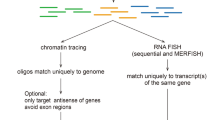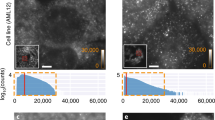Abstract
Multiplex-fluorescence in situ hybridization (M-FISH) was initially developed to stain human chromosomes — the 22 autosomes and X and Y sex chromosomes — with uniquely distinctive colors to facilitate karyotyping. The characteristic spectral signatures of all different combinations of fluorochromes are determined by multichannel image-analysis methods. Advantages of M-FISH include rapid analysis of metaphase spreads, even in complex cases with multiple chromosomal rearrangements, and identification of marker chromosomes. The M-FISH technology has been extended to other species, such as the mouse. Furthermore, in addition to painting probes, the method has been used with a variety of region-specific probes. M-FISH has even recently been used for 3D studies to analyze the distribution of human chromosomes in intact and preserved interphase nuclei. Hence, M-FISH has evolved into an essential tool for both clinical diagnostics and basic research. In this protocol, we describe how to use M-FISH to karyotype chromosomes, a procedure that takes ∼14 d if new M-FISH probes have to be generated and 3 d if the M-FISH probes are ready to use.
This is a preview of subscription content, access via your institution
Access options
Subscribe to this journal
Receive 12 print issues and online access
$259.00 per year
only $21.58 per issue
Buy this article
- Purchase on Springer Link
- Instant access to full article PDF
Prices may be subject to local taxes which are calculated during checkout




Similar content being viewed by others
References
Speicher, M.R. & Carter, N.P. The new cytogenetics: blurring the boundaries with molecular biology. Nat. Rev. Genet. 6, 782–792 (2005).
Speicher, M.R., Ballard, S.G. & Ward, D.C. Karyotyping human chromosomes by combinatorial multi-fluor FISH. Nat. Genet. 12, 368–375 (1996).
Schröck, E. et al. Multicolor spectral karyotyping of human chromosomes. Science 273, 494–497 (1996).
Tanke, H.J. et al. New strategy for multi-colour fluorescence in situ hybridisation: COBRA: COmbined Binary RAtio labelling. Eur. J. Hum. Genet. 7, 2–11 (1999).
Nederlof, P.M. et al. Multiple fluorescence in situ hybridization. Cytometry 11, 126–131 (1990).
Fauth, C. & Speicher, M.R. Classifying by colors: FISH-based genome analysis. Cytogenet. Cell Genet. 93, 1–10 (2001).
Azofeifa, J. et al. An optimized probe set for the detection of small interchromosomal aberrations by 24-color FISH. Am. J. Hum. Genet. 66, 1684–1688 (2000).
Jentsch, I., Geigl, J., Klein, C.A. & Speicher, M.R. Seven fluorochrome mouse M-FISH for high resolution analysis of interchromosomal rearrangements. Cytogenet. Genome Res. 103, 84–88 (2003).
Jentsch, I., Adler, I.D., Carter, N.P. & Speicher, M.R. Karyotyping mouse chromosomes by multiplex-FISH (M-FISH). Chromosome Res. 9, 211–214 (2001).
Brown, J. et al. Subtelomeric chromosome rearrangements are detected using an innovative 12-colour FISH assay (M-TEL). Nat. Med. 7, 497–501 (2001).
Fauth, C. et al. A new strategy for the detection of subtelomeric rearrangements. Hum. Genet. 109, 576–583 (2001).
Codina-Pascual, M. et al. Crossover frequency and synaptonemal complex length: their variability and effects on human male meiosis. Mol. Hum. Reprod. 12, 123–133 (2006).
Codina-Pascual, M. et al. Behaviour of human heterochromatic regions during the synapsis of homologous chromosomes. Hum. Reprod. 21, 1490–1497 (2006).
Nietzel, A. et al. A new multicolor-FISH approach for the characterization of marker chromosomes: centromere-specific multicolor-FISH (cenM-FISH). Hum. Genet. 108, 199–204 (2001).
Karhu, R. et al. Chromosome arm-specific multicolor FISH. Genes Chromosomes Cancer 30, 105–109 (2001).
Bolzer, A. et al. Three-dimensional maps of all chromosome positions indicate a probabilistic order in human male fibroblast nuclei and prometaphase rosettes. PLoS Biol. 3, e157 (2005).
Telenius, H. et al. Cytogenetic analysis by chromosome painting using DOP-PCR amplified flow-sorted chromosomes. Genes Chromosomes Cancer 4, 257–263 (1992).
Gribble, S., Ng, B.L., Prigmore, E., Burford, D.C. & Carter, N.P. Chromosome paints from single copies of chromosomes. Chromosome Res. 12, 143–151 (2004).
Thalhammer, S., Langer, S., Speicher, M.R., Heckl, W.M. & Geigl, J.B. Generation of chromosome painting probes from single chromosomes by laser microdissection and linker-adaptor PCR. Chromosome Res. 12, 337–343 (2004).
Eils, R. et al. An optimized, fully automated system for fast and accurate identification of chromosomal rearrangements by multiplex-FISH (M-FISH). Cytogenet. Cell Genet. 82, 160–171 (1998).
Rabbitts, P. et al. Chromosome specific paints from a high resolution flow karyotype of the mouse. Nat. Genet. 9, 369–375 (1995).
Author information
Authors and Affiliations
Corresponding author
Ethics declarations
Competing interests
The authors declare no competing financial interests.
Rights and permissions
About this article
Cite this article
Geigl, J., Uhrig, S. & Speicher, M. Multiplex-fluorescence in situ hybridization for chromosome karyotyping. Nat Protoc 1, 1172–1184 (2006). https://doi.org/10.1038/nprot.2006.160
Published:
Issue Date:
DOI: https://doi.org/10.1038/nprot.2006.160
This article is cited by
-
Chromosome instability and aneuploidy in the mammalian brain
Chromosome Research (2023)
-
Characterisation of the novel spontaneously immortalized and invasively growing human skin keratinocyte line HaSKpw
Scientific Reports (2020)
-
Autophagic cell death restricts chromosomal instability during replicative crisis
Nature (2019)
-
TP53 deficiency permits chromosome abnormalities and karyotype heterogeneity in acute myeloid leukemia
Leukemia (2019)
-
Alcohol and endogenous aldehydes damage chromosomes and mutate stem cells
Nature (2018)
Comments
By submitting a comment you agree to abide by our Terms and Community Guidelines. If you find something abusive or that does not comply with our terms or guidelines please flag it as inappropriate.



